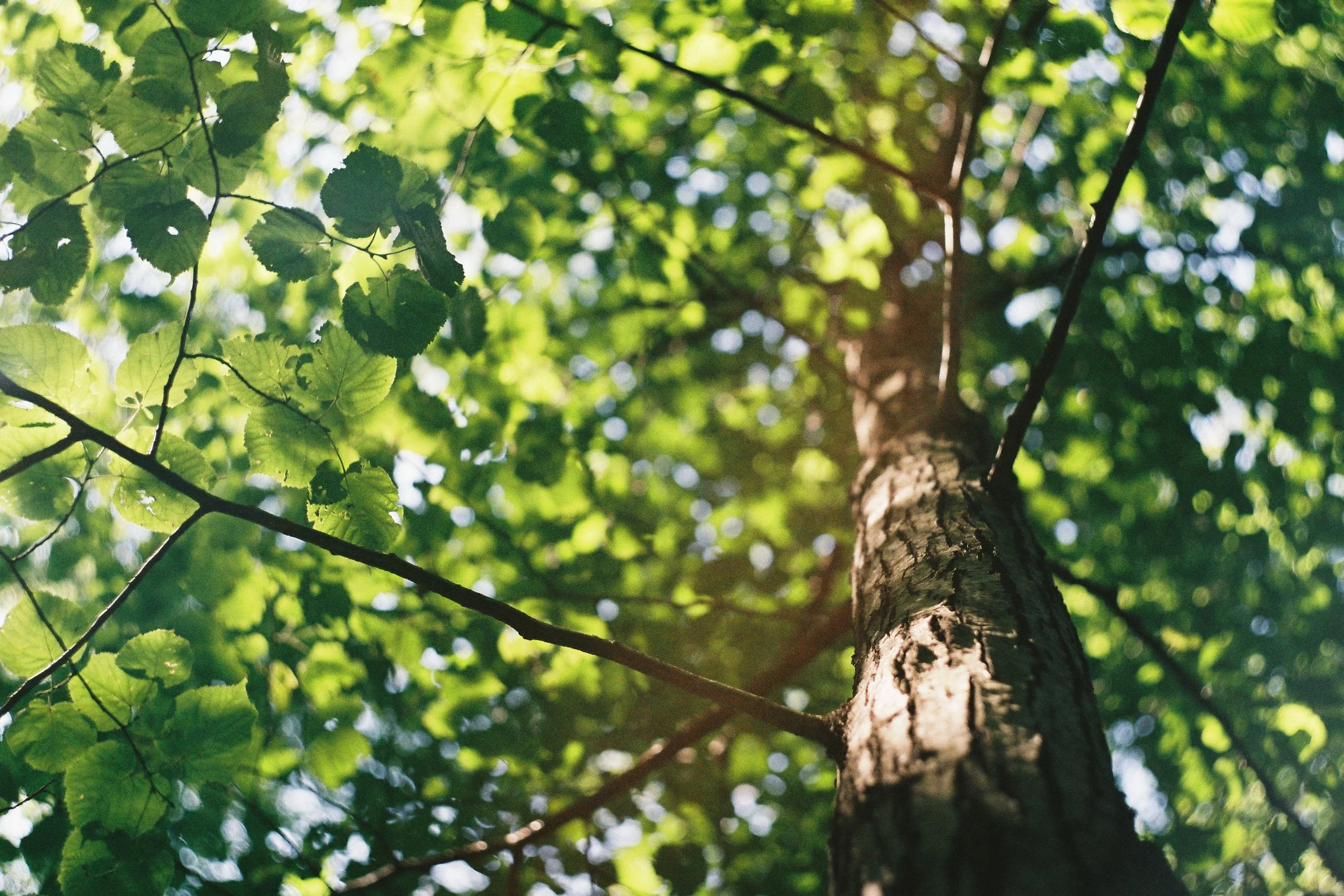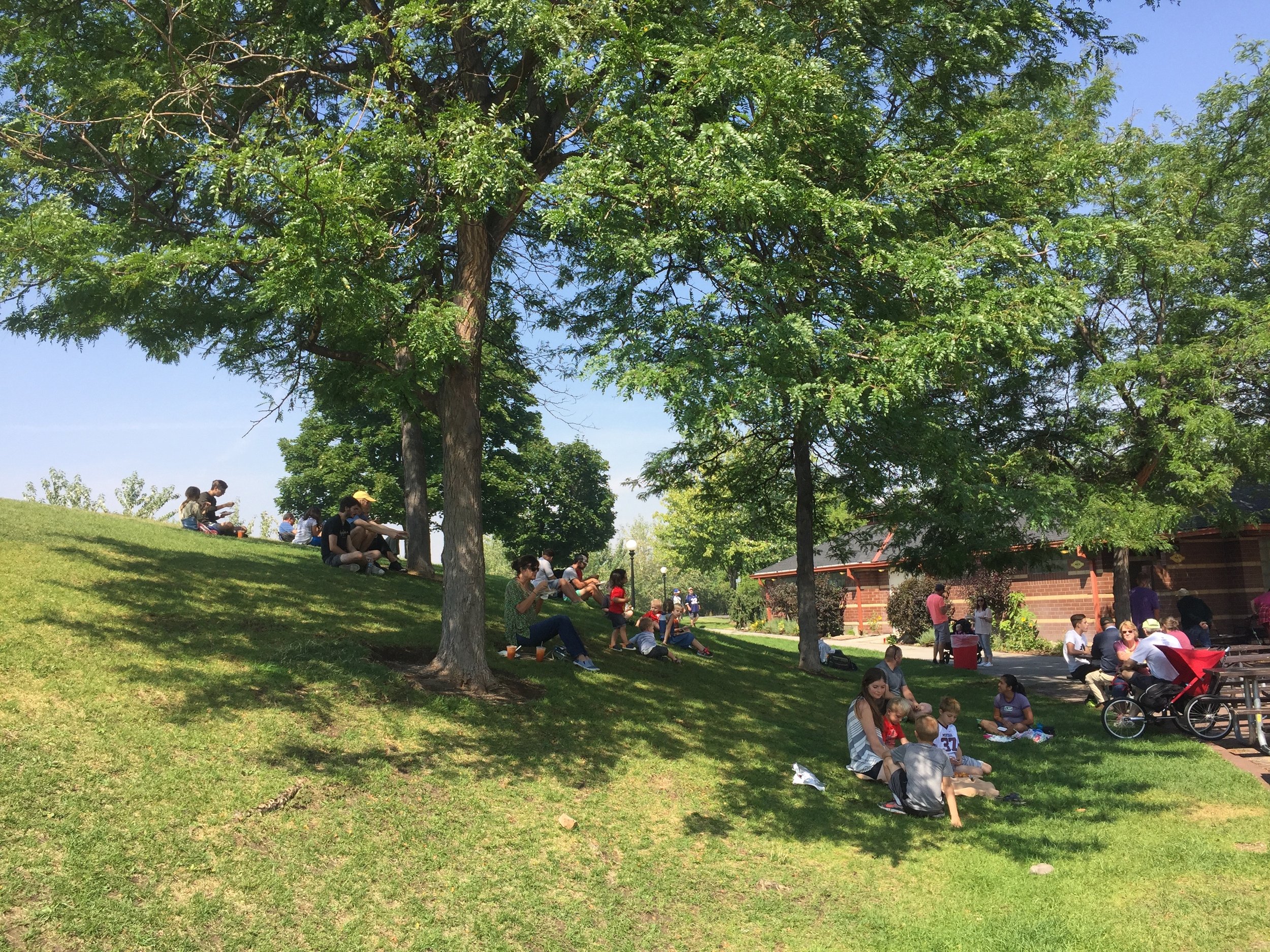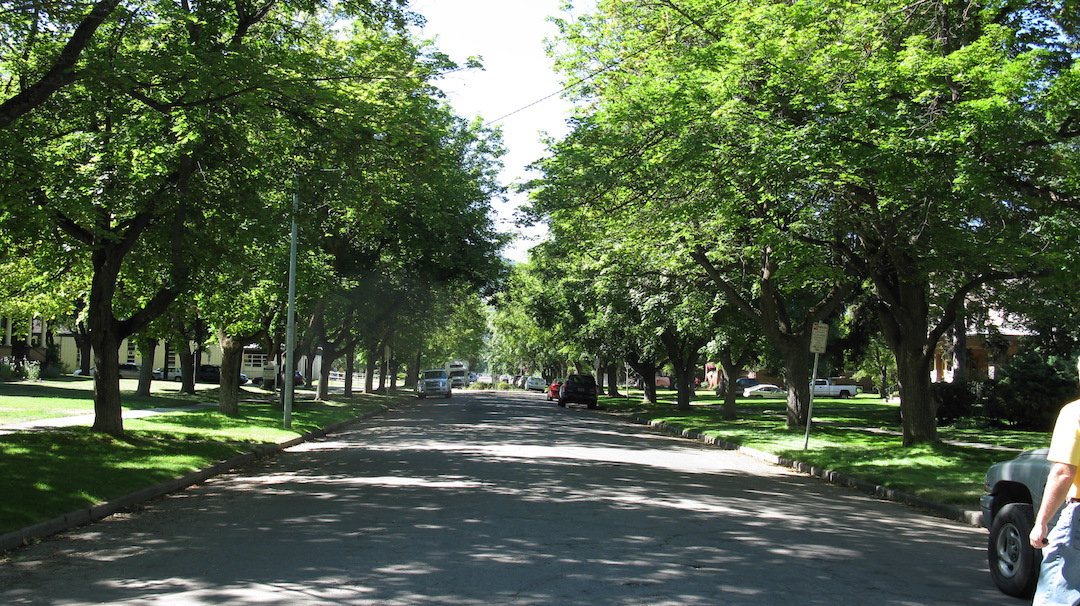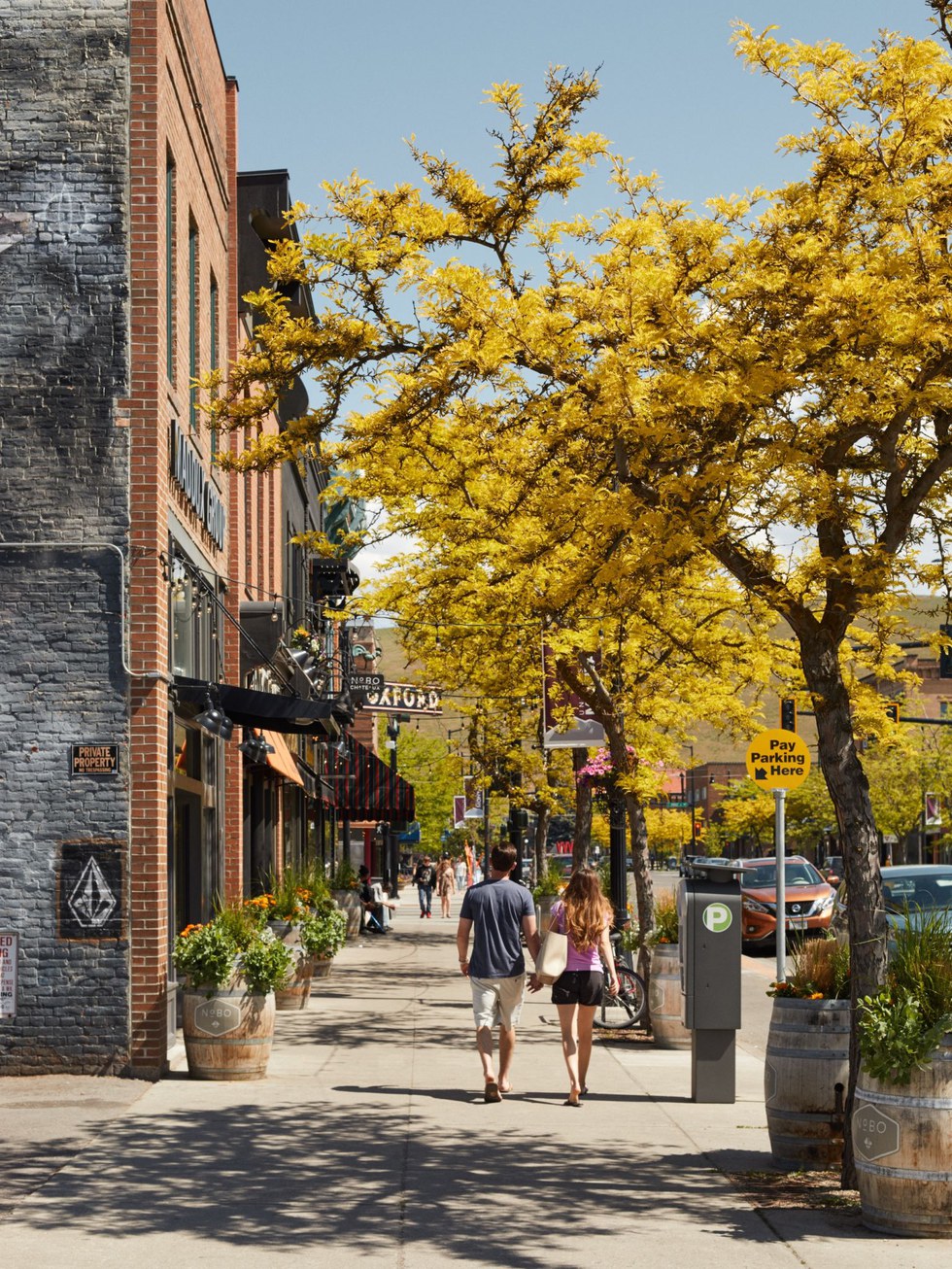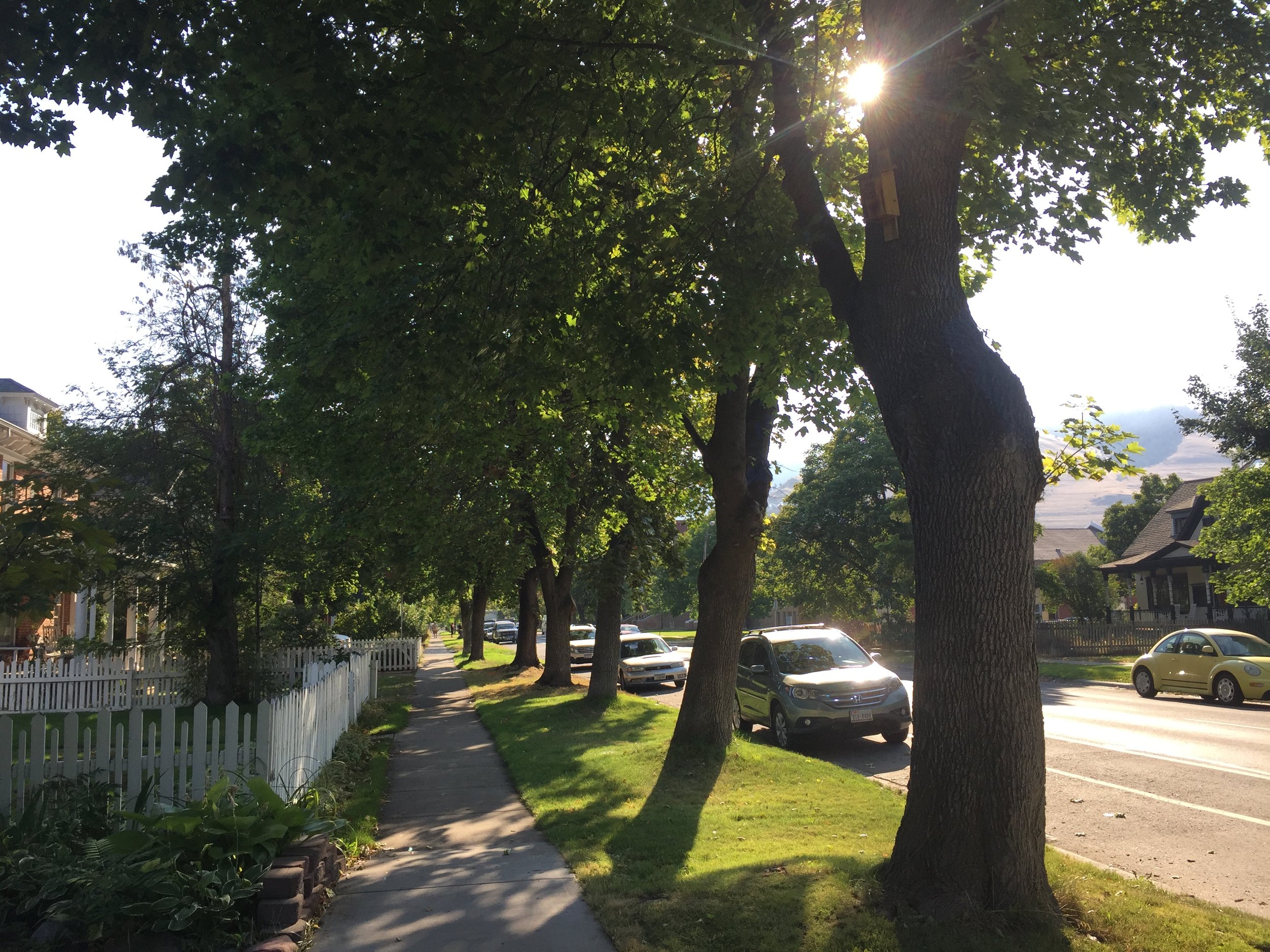Missoula's Urban Forest
The trees of Missoula’s urban forest provide countless environmental, health and social benefits. They have helped create Missoula’s unique character while fostering a strong sense of community.
History
“The first record of trees being imported into the Missoula valley dates to 1874 when Judge Frank Woody and Francis Worden planted the first fruit trees, cherry and apple. That same year Francis Worden planted imported Norway Maples around his home on East Pine Street.” - Missoula Urban Forest Master Management Plan, pg 15
With Missoula’s geological history, its valley floor is not ideal for trees.
“As the glacial lake filled and drained over the years, much of the top soil was stripped away leaving a flat valley floor with a thin, nutrient-poor soil layer covering a deep, gravelly bed. The City of Missoula was built directly on top of this layer and therefore does not have a soil base with adequate nutrients or water retention necessary for trees to grow and thrive. Before settlement, the Missoula valley was a broad plane without trees except for the small riparian zones of the Clark Fork River and its tributaries.”
- Missoula Urban Forest Master Management Plan, pg 15
Considering the geological events that left minimal soil combined with Missoula’s semi-arid climate, extra care in choosing, planting and watering trees is an absolute necessity.
Missoula Urban Forest Facts (from 2013 Missoula Street Tree Inventory)
Number of Trees: 22,537 (As of May 2018 we have 29,656 trees that provide $102,029,830 in benefits.)
Replacement Value: $22.9 M
Property Values Increased: $2 M
Unique Species: 117
Stormwater Runoff Reduction: 12 M gallons annually
Air Pollutants Removed: 2,011 lbs. annually
Energy Saved: 1,926,018 Kwh and 181,726 Therms annually
Carbon Dioxide Sequestered: 290,483 lbs. annually
Carbon Dioxide Avoided: 335,941 lbs. annually
Interested in learning more about Missoula’s urban forest?
Missoula Urban Forest FAQ’s
What is an urban forest?
An urban forest is comprised of all the trees and shrubs within city limits. Missoula’s Urban Forestry Division is responsible for almost 30,000 of those trees.
How do I find out if a tree on my property is within the public right-of-way?
Contact Urban Forestry at 552-6253 or manderson@ci.missoula.mt.us
I have a tree in the public right-of-way that needs inspecting. Who should I contact?
If you have a tree in the City of Missoula right-of-way showing signs of stress, contact Urban Forestry at 552-6253 or manderson@ci.missoula.mt.us.
I have noticed a tree on a street or in a park that looks like it is failing. Who should I contact?
If you notice a tree or trees in City right-of-way or a park showing signs of stress, contact Urban Forestry at 552-6253 or manderson@ci.missoula.mt.us.
A sidewalk, street, street sign, intersection or alley is being obstructed by vegetation. Who should I contact?
If a SIDEWALK is being obstructed by vegetation, contact Urban Forestry at 552-6253 or manderson@ci.missoula.mt.us
If a STREET is being obstructed by vegetation, contact Urban Forestry at 552-6253 or manderson@ci.missoula.mt.us
If a STREET SIGN is being obstructed by vegetation, contact Urban Forestry at 552-6253 or manderson@ci.missoula.mt.us
If an INTERSECTION is being obstructed by vegetation, contact Urban Forestry at 552-6253 or manderson@ci.missoula.mt.us
If an ALLEY is being obstructed by vegetation, contact Urban Forestry at 552-6253 or manderson@ci.missoula.mt.us
New construction/sidewalk/excavation is posing a potential conflict with a tree. Who should I contact?
Construction near or around an existing public tree can pose a serious threat to the health of that tree. Measures can and should be taken to protect trees during the construction process.
If you are concerned or have questions about protecting a tree in a construction area, contact Urban Forestry at 552-6253 or manderson@ci.missoula.mt.us.
What if my neighbor won’t trim their private tree?
If the issue is creating a risk in the public right-of-way, contact Urban Forestry at 406.552.6253 or manderson@ci.missoula.mt.us.
Missoula Parks & Recreation otherwise has no jurisdiction over private property. We encourage you to speak with your neighbor or homeowners’ association to resolve any issues.
My private tree needs inspecting. Who should I contact?
The City of Missoula website lists local certified arborists licensed with the City.
https://www.ci.missoula.mt.us/596/Local-Certified-Arborists-List
The International Society of Arboriculture (ISA) website lists certified arborists by area.
http://www.isa-arbor.com/findanarborist/findanarborist.aspx
Missoula County Extension and Weed District’s Plant Clinic can help with plant care and pest management issues. Bring in samples of bugs, plants and/or disease problems to be identified and find information on how to control them.
http://www.missoulaeduplace.org/plant-clinic.html
What is a certified arborist and why is one required to be able to work on publicly owned trees?
The International Society of Arboriculture (ISA), the regulatory body for certified professional tree care, tests and certifies an individual's knowledge in the field of arboriculture. ISA certifies that an individual has attained a generally accepted level of knowledge in such areas as tree biology, diagnosis, maintenance practices, safety and other subject and practice areas within the tree care profession.
The City of Missoula requires all tree care within city ROW to be under the guidance of a certified arborist. The City currently employs four certified arborists and three tree risk assessors.
How can I get a new boulevard tree?
Tree-planting sites must be inspected for suitability, size of boulevard space, underground and overhead utilities, infrastructure and irrigation. Once a site has been approved for planting, the corresponding address is added to a planting waitlist. To find out if a boulevard site is suitable for tree planting, contact Urban Forestry at 406.552.6253 or manderson@ci.missoula.mt.us.
How long is the tree planting waitlist?
The waitlist is dependent upon when requests are made, not necessarily by the number of requests. The City’s planting plans are solidified by January, and the trees are planted by the following June. If your tree-planting request is approved before the planting plans have been solidified, your tree should be planted that season. If your tree-planting request is approved after the planting plans have been solidified, you will most likely receive your tree the following planting season.
Can I get a tree planted sooner?
If you would like a tree planted immediately, your planting site must first be inspected and approved for suitability. You can then hire a certified arborist who will then apply for a no-fee permit. You will be responsible for purchasing the tree chosen from your Neighborhood Planting Plan if one exists or the City’s Approved Street Tree List.
For more information about contracting tree-planting services within public right-of-way, contact Urban Forestry at 552-6253 or manderson@ci.missoula.mt.us.
Can I choose the tree that will be planted in my boulevard?
To ensure a tree’s survivability, it is important to choose a species appropriate for Missoula’s climate and physical environment. Missoula’s Urban Forestry Division has researched and created an extensive list of approved street trees that are also appropriate for planting in your yard. http://www.ci.missoula.mt.us/DocumentCenter/View/26551
Missoula’s Urban Forestry Division and Office of Neighborhoods have recently collaborated to establish Neighborhood Tree Advisory Committees. These committees have created Neighborhood Planting Plans to help preserve and guide the future character of each neighborhood. To find out if your neighborhood has a planting plan or if you are interested in joining a Neighborhood Tree Advisory Committee, contact Urban Forestry at 552-6253 or manderson@ci.missoula.mt.us.
My boulevard tree was removed and not replaced. Why?
Not all sites were suitable for street trees to be planted originally, and therefore, will not be replaced. Site suitability depends on size of boulevard space, underground and overhead utilities, infrastructure and irrigation in addition to other factors.
I am planting a tree in my yard. Do you have planting instructions?
Please refer to these City of Missoula Parks & Recreation approved planting notes and details PDFs
Do Missoula’s trees need to be watered?
In a word, yes. Trees planted in Missoula need supplemental watering during the hottest, driest months of July, August and September. Missoula’s climate is classified as semi-arid, receiving only 14” precipitation per year, while most trees planted in Missoula require an average of 25-35” of water. Additionally, the Missoula valley generally does not have a soil base with adequate nutrients or water retention necessary for trees to grow and thrive. Before settlement, the Missoula valley was a broad plane without trees except for the small riparian zones of the Clark Fork River and its tributaries.To ensure survival in Missoula’s climate and physical environment, all trees require water the first few years after planting. Even native and drought-tolerant trees, though not as much as other trees, still need some supplemental water during the hottest and driest months to thrive.
What are the responsibilities of a property owner or renter to the street trees adjacent to their property?
The owner of a property adjacent to a public tree is responsible for watering the tree.
How do I water my trees effectively/efficiently?
In order to not waste water when watering a tree, it is important to understand where to direct the water, the absorbing roots at and outside the tree’s drip line. There are varying watering methods. If possible, utilize a method that keeps the water close to the ground to avoid loss due to evaporation, such as a soaker hose, a garden hose on very slow drip or drip irrigation. If using a sprinkler, keep the spray as low as possible and avoid watering impervious surfaces. It is important the water is absorbed into the ground and not running off of it.
How do I know how much water my trees need?
Generally, during the driest and hottest months, July, August and September, water your trees at least one hour a week. To find more detailed information about how much you should water your trees: https://www.ci.missoula.mt.us/293/How-Much-Water-do-My-Trees-Need
How can I volunteer and help our city’s trees?
Trees for Missoula, an urban forest advocacy and volunteer group, is always looking for community members interested in trees and the urban forest to help in a variety of ways from pruning and planting to grant writing.
For more information about how you can help the urban forest, check out our volunteer page.

